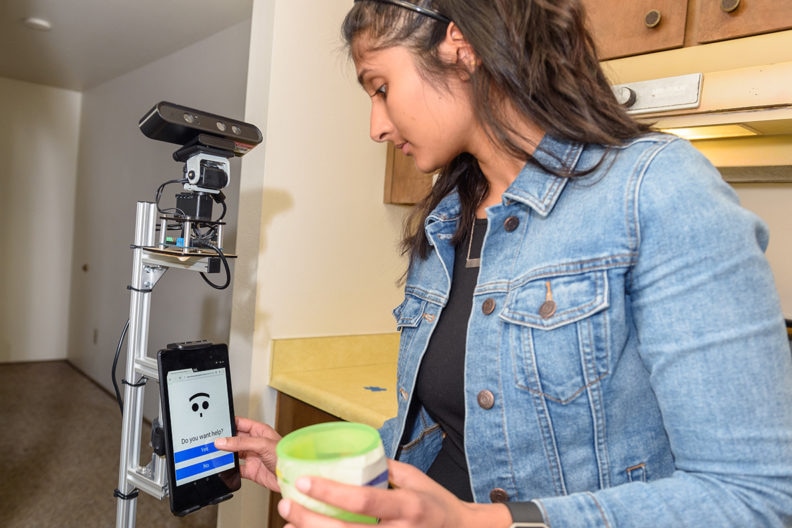Jan 16 2019
Researchers from Washington State University (WSU) have created a robot that could help elderly people with dementia and other limitations to live independently in their own homes.
 WSU master’s student Nisha Raghunath, of Portland, Oregon, demonstrates the interactions between a human and a helper robot Tuesday, January 8, 2019 at the WSU Smart Apartment in Pullman. The robot senses when the subject makes a mistake in daily tasks and offers assistance to help the person accomplish their tasks. (Image credit: Washington State University)
WSU master’s student Nisha Raghunath, of Portland, Oregon, demonstrates the interactions between a human and a helper robot Tuesday, January 8, 2019 at the WSU Smart Apartment in Pullman. The robot senses when the subject makes a mistake in daily tasks and offers assistance to help the person accomplish their tasks. (Image credit: Washington State University)
The Robot Activity Support System (RAS) uses sensors embedded in a WSU smart home to establish where its residents are, what they are doing and when they need help with everyday activities.
It steers through rooms and around obstacles to locate people on its own, provides video instructions on how to do simple jobs and can even lead its owner to objects like a snack in the kitchen or their medication.
RAS combines the convenience of a mobile robot with the activity detection technology of a WSU smart home to provide assistance in the moment, as the need for help is detected.
Bryan Minor, Postdoctoral Researcher, WSU School of Electrical Engineering and Computer Science.
Minor works in the lab of Diane Cook, Regents professor of electrical engineering and computer science and director of the WSU Center for Advanced Studies in Adaptive Systems.
For the last ten years, Cook and Maureen Schmitter-Edgecombe, a WSU professor of psychology, have guided CASAS scientists in the development of smart home technologies that could assist elderly adults with memory problems and other impairments to live self-sufficiently.
At present, an estimated 50% of adults over the age of 85 require assistance with daily activities such as making meals and taking medication and the yearly cost for this assistance in the US is almost $2 trillion.
With the number of adults over 85 projected to triple by 2050, Cook and Schmitter-Edgecombe are optimistic that technologies like RAS and the WSU smart home will ease some of the financial strain on the healthcare system by making it easier for older adults to live on their own.
“Upwards of 90 percent of older adults prefer to age in place as opposed to moving into a nursing home,” Cook said. “We want to make it so that instead of bringing in a caregiver or sending these people to a nursing home, we can use technology to help them live independently on their own.”
RAS is the first robot CASAS scientists have tried to integrate into their smart home environment. They recently published a research in the journal Cognitive Systems Research that shows how RAS could make life easier for the elderly struggling to live self-sufficiently.
In the study
CASAS scientists enlisted 26 undergraduate and graduate students to complete three activities in a smart home using RAS as an assistant.
The activities were taking medication with food and water, getting ready to walk the dog, and watering household plants.
When the smart home sensors detected a human was unsuccessful to initiate or was finding it hard to do one of the tasks, RAS received a message to assist.
The robot then used its mapping and navigation camera, sensors, and software to locate the person and provide assistance.
The person could then specify through a tablet interface that they wanted to view a video of the next step in the task they were performing, a video of the whole activity or they could ask the robot to guide them to objects needed to do the activity like the dog’s leash or a granola bar from the kitchen.
Later the study participants were requested to rate the robot’s performance. The majority of the participants rated RAS’ performance positively and found the robot’s tablet interface to be easy to use. They also reported the next step video as being the most beneficial of the prompts.
While we are still in an early stage of development, our initial results with RAS have been promising. The next step in the research will be to test RAS’ performance with a group of older adults to get a better idea of what prompts, video reminders and other preferences they have regarding the robot.
Bryan Minor, Postdoctoral Researcher, WSU School of Electrical Engineering and Computer Science.